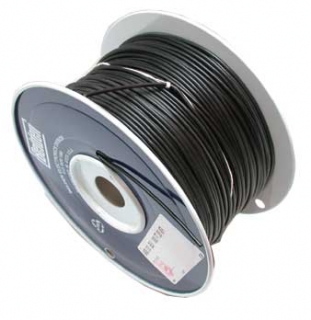Wire size and insulation greatly affect loop performance — how well inductance change caused by a passing vehicle is presented to the detector.
A loop's ability to reflect an inductance change is increased with large wire sizes such as No. 14 or No. 12 American Wire Gauge (AWG) because resistance is negligible. Wire can be solid or stranded aluminum or copper. Stranded copper is a good choice. It is easier to form into a loop, and copper is less resistive that aluminum.

Station or Site Conditions
Type TW (moisture-resistant thermoplastic) or type THW (moisture and heat resistant thermoplastic) wire with polyvinyl chloride (PVC) insulation is adequate for both loop and lead-in under these conditions; short term installations (3 to 5 years) at dry sites on gravel roads and where short lead-ins (30 feet or less) are possible. Because of the number of small pinholes in PVC insulation, the loop can be grounded out on long lead-ins where wet conditions exist.
A better choice for wet conditions is polyethylene (PE) insulation. Any insulation has pinhole flaws that allow conductive paths to form from the wire when the ground is moist. But PE is manufactured by a process that involves through melting of the material, resulting in fewer pinholes than PVC.
Type USE (underground service entrance) or type UF (underground feeder) direct burial wire insulated with PE offers the maximum resistance to moisture and damage for loops. (Type USE and UF can be purchased with PE insulated conductors even though the outer jacket may be PVC.)
Where wire could come into contact with hot tar or hot asphalt, as when roads are being resurfaced, wire with silicon rubber insulation may be a good compromise. It is not as mechanically durable as PE insulation but withstands temperatures to 300o F.
Lead-Ins
Large wire sizes—No. 14 and No. 12 AWG—should also be used for lead-ins. Specific types of wire and insulation depend on the site and lead-in length.
For short lead-ins at dry sites, type TW or THW wire with PVC insulation is adequate. Type USE and UF wire should not be used for lead-in wire. Lead-ins should be twisted at least five turns per foot throughout their length. Twisting the wire together eliminates any small “loops,” which can occur in the wire otherwise. Such “loops” increase lead-in inductance reducing the installation’s ability to detect traffic.
Lead-in inductance must be kept small because a passing vehicle rarely reduces loop inductance more that 1 or 2 percent. (The exact percentage depends on how nearly the vehicle fills the loop.) By adding a large lead in inductance, the vehicle caused drop in inductance becomes proportionately even smaller. When large lead-in inductances “dilute” vehicle caused reductions in this way, the detector cannot always “sense” the change, and counting accuracy declines.
Capacitance is an important concern in wire selection, particularly when choosing a wire for long lead-ins, since it, too, has the effect of boosting lead-in inductance. The capacitance of wire is rated in picofarads per foot (pF/ft). Wire lead-ins should be rated at 25 pF/ft or less at 70o F. Capacitance varies with temperature and moisture, so a good insulation can minimize these effects.
For long lead-ins wire insulated with cross linked PE instead of PVC to limit capacitance. The capacitance of PE and PVC are about the same at 70o F. But for each 10 degrees of temperature change, the capacitance of PVC changes about 5 percent, that of PE is less than 0.1 percent.
Since self tuning detectors must track that change, and manually tuned detectors require retuning, it is best to limit capacitance changes by choosing wire insulated with PE.



 The article has been updated successfully.
The article has been updated successfully.



